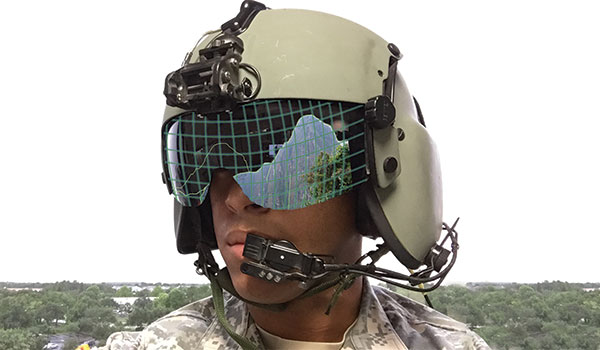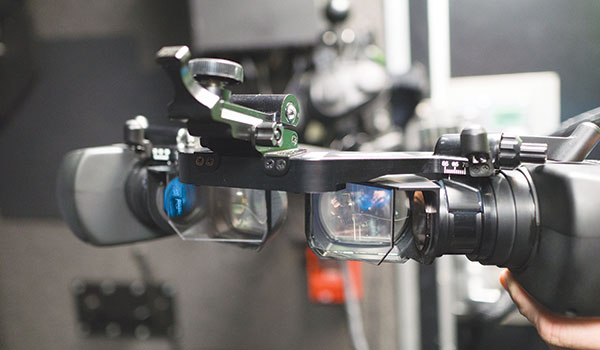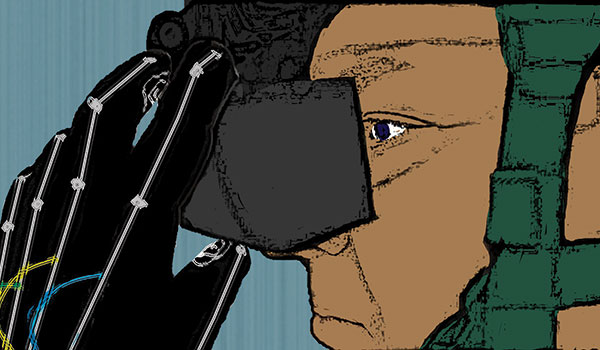
From the Field / By MAJ Robert A. Crapanzano: “Chalk one is coming off comms,” CW4 Espinosa transmitted before turning off the simulator. In the copilot’s seat, Lieutenant Trimble disconnected his virtual reality goggles from his helmet and set it on the center console. e cockpit, that moments ago looked and felt like the inside of a UH-60V helicopter, now was a series of at black panels. Where his digital multi-function displays and center console switches used to be was now a piece of sheet metal dotted with micro position sensors. Instead of seeing the air.eld outside his window, he now saw the blank inside walls of the simulator room. Moments ago he was piloting a helicopter in a digital world, and now the only artifacts in the room that still resembled the inside of the Blackhawk were the ¯ight controls and CW4 Espinosa seating in the seat next to him. Everything else was black panels and aluminum walls.

Synthetic Training Environment Helmet / U.S. ARMY PHOTO BY MAJ ROBERT CRAPANZANO, PEO STRI
Lieutenant Trimble finished removing his helmet. He unplugged his tactile feedback gloves and goggles. He set them on the panel that just moments ago looked like the center console of a helicopter.
“Good job today, sir,” CW4 Espinosa said while looking over at him with a thumbs up. “You did pretty good for your first time in the STE. What did you think of it?” The lieutenant replied, “It was weird at first, but after a few minutes I got used to it. The goggles are actually really clear, just like Hi Def TV, and it really felt like I was touching knobs and switches.”
CW4 Espinosa held up one of her gloves, “Yeah, these gloves are pretty amazing. I’m not sure how they work, but they are pretty cool. It feels like you are pressing a button, even though…” she pointed at the center console, “there is nothing actually here except a flat panel.” Lieutenant Trimble began inspecting the tactile feedback gloves and squeezing the micro switches.
“Got any questions before we head to the AAR?” CW4 Espinosa asked.“A bunch,” the lieutenant replied and then looked at the notes on his knee board. “Ok. First off, the convoy was the 2nd Infantry Brigade, right? …didn’t they deploy last week. How were they training with us?”
CW4 Espinosa realized that she overestimated Lieutenant Trimble’s knowledge of the STE. She began to explain, “They did deploy, but haven’t arrived in country yet. They are still at the Gateway Center doing theater specific training. They will fly into the country next week.”
“So they have simulators like this at the Gateway?” Trimble asked.
“No, they don’t. They are using their mobile simulators, basically desktop computers with the light gaming version of the STE. Their fully immersive simulators are still at Fort Hood,” CW4 Espinosa replied.
“Ah… ok. That makes sense now,” Lieutenant Trimble said with a smile. “And how about the infantry platoon that we dropped off. Are they at the Gateway too?”
“No,” CW4 Espinosa made a mental note that she should have explained this better before the mission, “They were AI.”

Legacy head mounted display
“AI?” The lieutenant asked perplexed. “Yeah, AI. Like Artificial Intelligence. Computers,” she replied.
“But they were talking to us?” the lieutenant said as he recalled the events of the mission, “Cannibal Six talked to us as they loaded at the PZ, gave us an update, and even said ‘Thanks for the ride.’?”
“Yep, AI.” CW4 Espinosa replied.
Lieutenant Trimble still wasn’t convinced that they were computer generated entities. “But how did they know to clear that bridge?”
“That’s all part of their program,” Espinosa tried to think of a better way to explain it, “Clearing the bridge was a tactical task assigned by division planners, actions on contact are part of the AI algorithms, and the speech, including the slight country twang, are all designed to make the scenarios more realistic for us, the pilots. I personally enjoy the accents that the AI British soldiers have.”
The lieutenant was more confused than ever. “Ok. So the infantry company that assaulted the village. They were AI too?”
“Nope,” CW4 Espinosa chuckled, “They were live.”
“Live?” the lieutenant said in utter confusion.
“Yep. Live,” CW4 Espinosa said with a smile, “that village is an urban training site at Fort Hood. That infantry company was actually on the ground in the real world fighting against a real live opposing force. Obviously they use blank ammo, but they put sensors on each person and import the data into the STE. This way, we can talk to each other and see each other in Blue Force Tracker”.
“I can’t believe this,” Lieutenant Trimble said while shaking his head at his own naivety, “I thought that everyone in the STE had a simulator just like ours.”
“Nope, not at all.” CW4 Espinosa explained, “All the players can have different sims based upon their capabilities and training objectives, cloud based service on demand is what they call it.
“Look at aviation for example. Our current sim is flexible. By using the virtual reality goggles and tactile gloves, we can simulate any of our aircraft including the Future Vertical Lift. But alternatively, we could also use the desktop computer version of the STE. We use those a lot down range for mission rehearsals.”
“Wow,” Lieutenant Trimble had a lot to take in, “The scenario felt so real. I had no clue that there were so many moving parts.”
“But that’s the point,” CW4 Espinosa replied, “You shouldn’t have to worry about any of that stuff. You should be able to plan and execute your mission seamlessly without worrying about how these systems are connected or which soldier is live, virtual, or a WARSIM entity.”

Notional Synthetic Training Environment gloves and display
Just as Lieutenant Trimble was starting to make sense of the STE, he was thrown a new term. “WARSIM?” he asked.
“Yeah, Warfighter Simulation, WARSIM. Do you remember the brigade that was operating to the south? Well they weren’t live, virtual, or AI. They were WARSIM units. Basically staff officers role play platoon, company, or even battalion size units. In the STE we see a platoon of ten Joint Light Tactical Vehicles, but in reality they all receive mission commands from one operator. That is what you have to look forward to when you go to brigade or division staff.” CW4 Espinosa looked down at her watch. “I know you have more questions, but we need to meet the other chalks to dial into the AAR. We can talk more about this later.”
“Ok,” Lieutenant Trimble said as he checked the time on his smartphone.
“But hey Lieutenant,” CW4 Espinosa said as she looked at him and smiled, “I’m serious. You did a good job in the STE. That decision to do a go-around saved some soldiers’ lives today, even if they were just virtual.”
“Thanks, Ms. Espinosa.”
The preceding story is science fiction and takes place around the year 2030. Although fiction, it presents a very real training scenario that may be the future of simulations. The Army’s current simulators and collective training devices are great systems, but over the next decade, they will be challenged to work together across domains in an integrated training environment. The Synthetic Training Environment (STE) will solve many of these challenges by redesigning these training devices from the ground up, with interoperability as a primary objective of the design process. Furthermore, the STE will capitalize on the advances of gaming, cloud-based information, and information technology to create a realistic training collective environment.
Current Limitations
An underlying problem with the Army’s current training devices is that they are ‘stovepipe’ systems. They were designed to meet specific, local requirements, and are not very good at sharing information across programs. For example, the Aviation Combined Arms Tactical Trainer (AVCATT) is designed to allow six medium fidelity aircraft simulators to operate together in a collective environment. They use terrain databases and computer generated entities that are tailored to aircraft operations. A pilot does not need to see highway street signs, but does require that missile trajectories reflect real world behavior. On the contrary, in the Close Combat Tactical Trainer (CCTT), which trains tanks and Bradley Fighting Vehicles, vehicle commanders require more road details and do not care about the trajectory of a surface to air missile. For years, systems like these have been using individually tailored databases which make interoperability across a network very difficult. The STE will resolve these issues by utilizing universal cloud based databases.
As an overarching and cloud based program, the STE will also support multiple levels of fidelity as illustrated in the story of LT Trimble and CW4 Espinosa. Fully immersive training devices provide pilots with higher degrees of realism but alternatively a cloud based server could also support partially immersive desktop versions of training devices. Equipped with a joystick and a monitor, a pilot can fly in the STE at his company’s command post. This would be impossible using current simulator databases because they are too large and require too much processing power to operate on a standalone computer. By capitalizing on advances in the commercial gaming industry and cloud based technology, pilots can engage in the STE from a desktop computer or from higher fidelity simulators.
These challenges are some of the Aviation specific concerns that are driving the development of the STE, but there are numerous other benefits to the STE which include constructive exercises, integration with live training, and mission planning.
The Path Ahead
The STE is still in the early stages of conceptual design. It is currently an idea and there are not many program specifics outside a PowerPoint presentation. Even this article and the preceding story present one concept of the many that have been discussed. Over the next few years, integrated product teams and the Army leadership will begin to define the required capabilities for the STE. Shortly after that, the Army’s leadership will request funding for STE and establish it as a program of record. It will potentially be the largest simulation program in the Army’s history.
Although the program will take advantage of commercial-off-the-shelf products, there are still numerous technology gaps that must be overcome before the STE becomes a reality, such as tactile feedback gloves or network bandwidth limitations. The STE program manager will need to identify these gaps, evaluate different conceptual designs, and begin investing in the required technology development.
The STE objective is to support the operational domain of training which includes collective training from small tactical units up to Corps level Joint exercises. The National Simulation Center has outlined four major increments for the STE which will be delivered from 2023 to 2031. This first increment of the STE will focus on developing the cloud based architecture and databases required for the system. This first increment will be partially immersive and more than likely resemble a desktop game system. The second increment will be fully immersive and include significant improvements to the user interface. The fidelity of these second increment aviation training devices will resemble the AVCATT. The STE Air, which is the STE’s aviation training device, will ultimately replace the capabilities of the AVCATT as this legacy system reaches its end of life around 2033.
Conclusion – Fiction to Reality
The Synthetic Training Environment will bring science fiction into reality. The Army’s current simulators are stovepipe systems and are difficult to integrate, sustain, and keep concurrent with actual aircraft. The STE will resolve many of these challenges by developing cross compatible systems while capitalizing on the advances in gaming, cloud based, and information technology. Although the STE is in the very early stages of conceptual design and definition, it may potentially revolutionize simulation training over the next 15 to 30 years.
MAJ Robert A. Crapanzano is a Senior Army Aviator and Acquisition Corps officer at the Program Executive Office for Simulation, Training, and Instrumentation (PEO STRI). He is currently an assistant program manager for the Aviation Combined Arms Tactical Trainer (AVCATT), for the Project Manager Integrated Training Environment (PM ITE).








